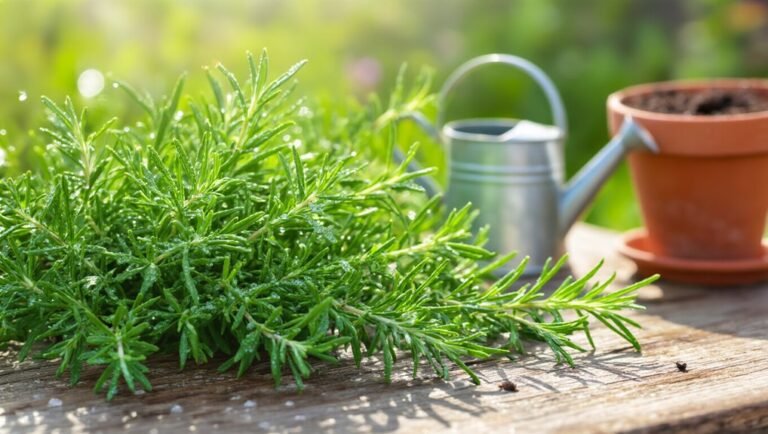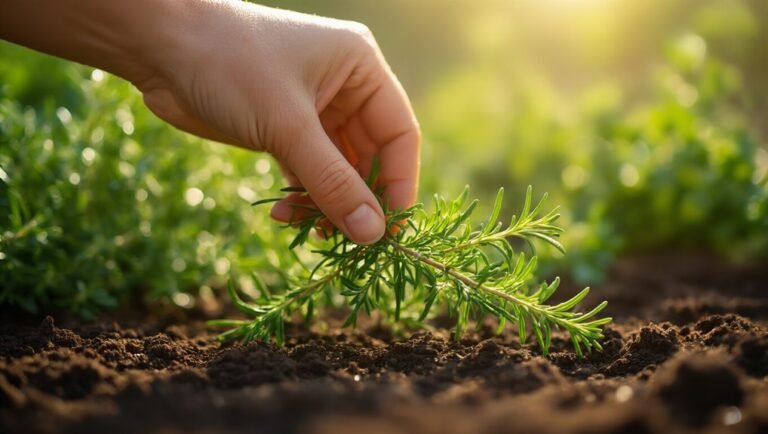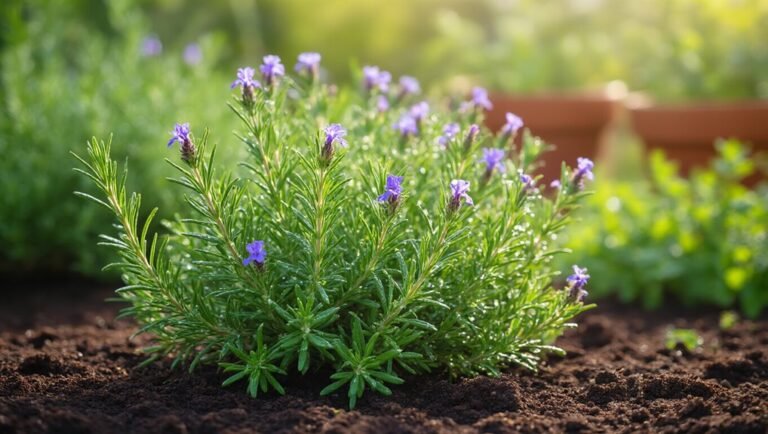To care for your flowers effectively, start by choosing seasonal varieties that fit the occasion. Prepare them by trimming stems at an angle and removing damaged petals. Use room-temperature water and place them in indirect light for longevity. Maintain humidity levels and change the water regularly. Keep an eye out for pests and adjust your care routine as needed. With these tips, you’ll ensure your blooms thrive beautifully, and there’s much more to discover!
Key Takeaways
- Choose seasonal flowers and match them to the occasion for vibrant and appropriate arrangements.
- Trim stems at a 45-degree angle and remove lower leaves to enhance water absorption and prevent bacterial growth.
- Place flowers in indirect light, avoiding drafts and heat sources to maintain freshness and longevity.
- Change water every few days and add nutrients for optimal flower health and appearance.
- Regularly inspect for pests and adjust care routines based on observed plant health to prevent issues.
Choosing the Right Flowers
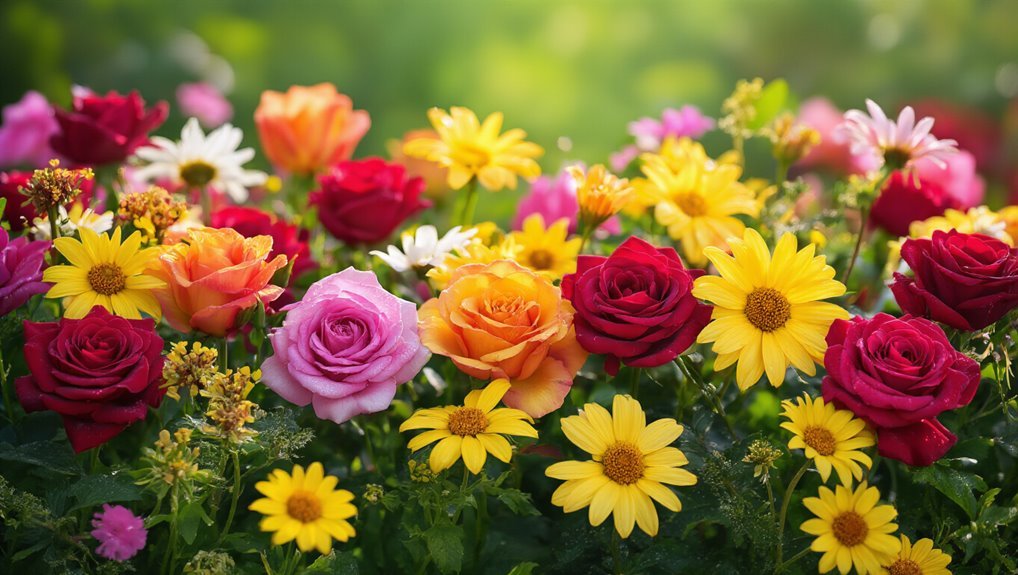
When you’re choosing the right flowers, what factors should you consider? Start with the occasion. Different events call for different blooms—think romantic roses for anniversaries or cheerful daisies for birthdays.
Next, consider the season. Seasonal flowers not only look vibrant but often cost less and last longer. For gardens, you might also take into account the benefits of insect repellent plants that can naturally protect your blooms from pests.
Pay attention to the color scheme as well; complementary colors can enhance your arrangement and create a striking visual impact.
Don’t forget about the fragrance! Some flowers, like lilies, have strong scents, while others, like sunflowers, are more subtle.
Finally, think about the size and shape of the flowers. Ensure they’ll fit well in your chosen vase or arrangement style.
If you’re interested in unique blooms, consider Edible Flower Seeds for arrangements that are both beautiful and suitable for culinary use.
Preparing Your Flowers for Arranging
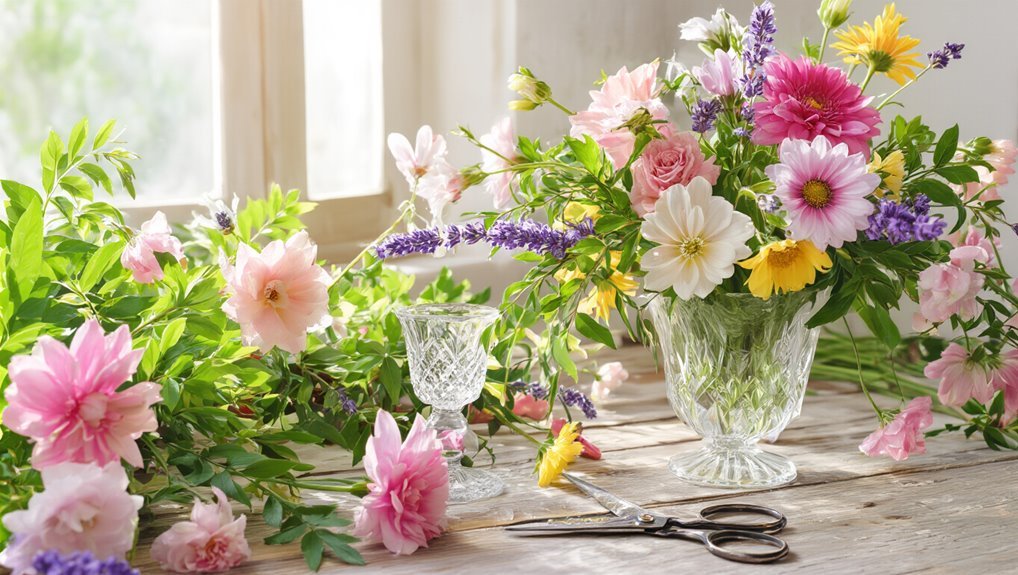
To prepare your flowers for arranging, start by trimming the stems at a 45-degree angle. This helps maximize water absorption and keeps your blooms fresh longer.
Next, remove any leaves that’ll sit below the waterline in your vase, as they can promote bacterial growth. Using a gardening tool set can make the process of leaf removal and stem cutting more efficient and precise.
Give your flowers a quick rinse under cool water to remove any dirt or debris, ensuring they’re clean before arranging.
If you have any wilted or damaged petals, pluck those off to keep your arrangement looking vibrant.
Lastly, group your flowers by type and color so you can visualize your arrangement better.
Taking these steps will set the foundation for a beautiful display that showcases your flowers at their best.
Using the right pruning shears makes the trimming process easier and ensures clean cuts, which can help your flowers stay fresh even longer.
Optimal Watering Techniques
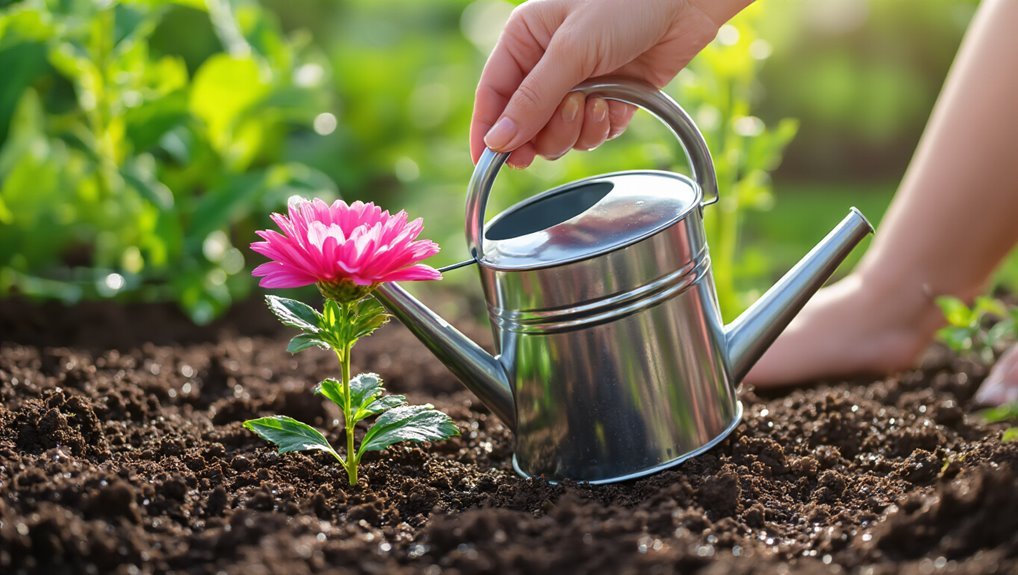
Proper watering techniques are crucial for keeping your flowers fresh and vibrant.
First, always use room-temperature water, as cold water can shock your blooms. When you water, aim for the base of the stems, avoiding the petals to prevent rot. To make watering even more convenient and effective, many gardeners rely on garden hoses to deliver water directly to plant roots, ensuring even coverage and reducing waste.
It’s best to check the water level daily; if the top inch of soil feels dry, it’s time to water. Make sure your containers have proper drainage to prevent waterlogging.
For cut flowers, trim the stems at an angle before placing them in water, ensuring they can absorb more. Change the water every few days to keep it clean and oxygenated.
To make watering even easier and more precise, consider using essential watering cans designed for every gardener, as they help you control water flow and reach plant bases efficiently.
With these techniques, you’ll help your flowers thrive and enhance their beauty.
Ideal Placement for Longevity
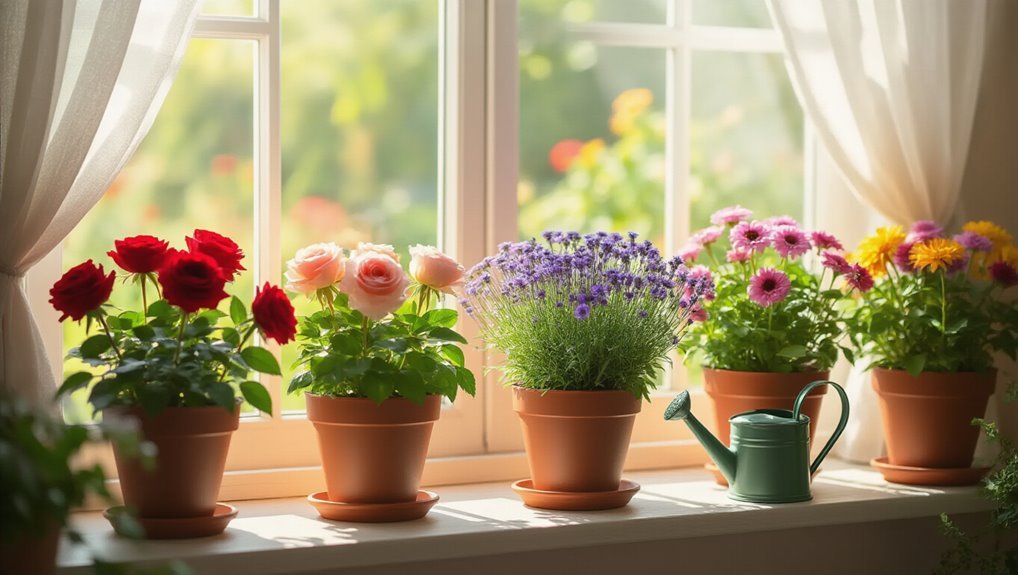
Although flowers can brighten any space, their placement significantly affects their longevity. To keep your blooms fresh for longer, consider these ideal locations. Avoid direct sunlight, as it can cause wilting and fading. Instead, choose spots with indirect light or partial shade. Additionally, keep flowers away from drafts and heating vents, which can lead to premature drying. For those who enjoy tending to their gardens, using gardening gloves helps protect your hands while arranging or handling flowers. For extra convenience and efficiency, consider garden gloves with claws as they make digging and planting tasks easier, saving you time in the garden.
Here’s a quick reference table to help you decide the best spots for your flowers:
| Placement | Effect on Longevity |
|---|---|
| Direct Sunlight | Causes wilting |
| Indirect Light | Promotes freshness |
| Drafty Areas | Dries out flowers |
| Humid Areas | Helps maintain moisture |
Maintaining Temperature and Humidity
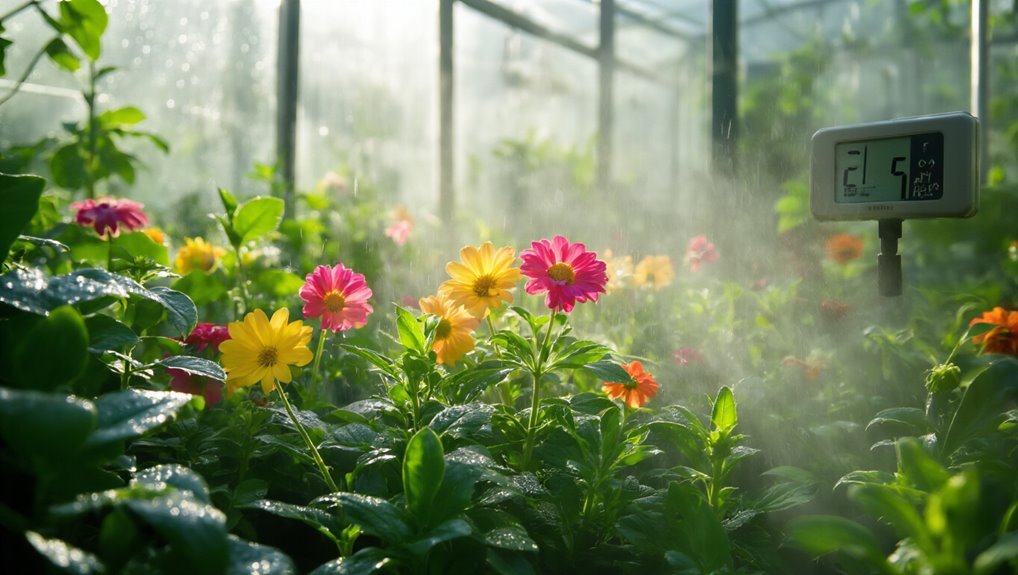
Maintaining the right temperature and humidity is just as important as finding the ideal placement for your flowers. Most blooms thrive in temperatures between 65°F and 72°F. Avoid placing them near heat sources or air conditioning vents, as extreme fluctuations can stress them out. For even better results, ensure you are using the best plant food options to provide balanced nutrition.
Humidity levels also play a crucial role; aim for around 40-60%. If your home is too dry, consider using a humidifier or placing a shallow dish of water nearby to boost moisture. Conversely, if it’s too humid, ensure there’s good air circulation to prevent mold.
Regularly check your flowers for signs of wilting or drooping, which can indicate that adjustments are needed. By keeping these conditions in mind, you’ll help your flowers stay vibrant and healthy longer. To further enhance your flower care routine, consider using Plant Fertilizer Tablets to provide essential nutrients for optimal growth and longevity.
The Importance of Clean Vases
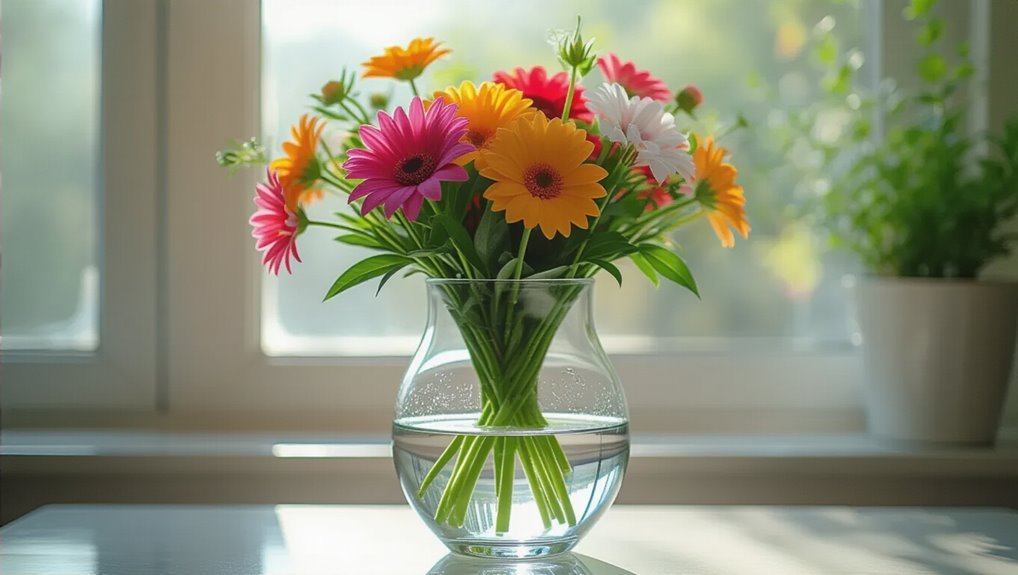
While you mightn’t think about it often, using clean vases is essential for keeping your flowers looking their best. A dirty vase can harbor bacteria and mold, which can quickly damage your beautiful blooms.
When you place fresh flowers in a contaminated vase, you’re setting them up for a premature decline. Make it a habit to wash your vases with hot, soapy water before using them. Rinse thoroughly to remove any residue. Adding organic mulch around your garden beds is another excellent strategy for protecting plant roots and maintaining soil health.
For stubborn stains or odors, a mixture of vinegar and baking soda can work wonders. By ensuring your vases are clean, you’re giving your flowers the best chance to thrive, stay vibrant, and last longer.
Clean vases contribute significantly to the overall health of your floral arrangements. If you’re interested in keeping your garden healthy in other ways, consider using compost bins to enrich your soil and support vibrant plant growth.
Regular Maintenance and Trimming
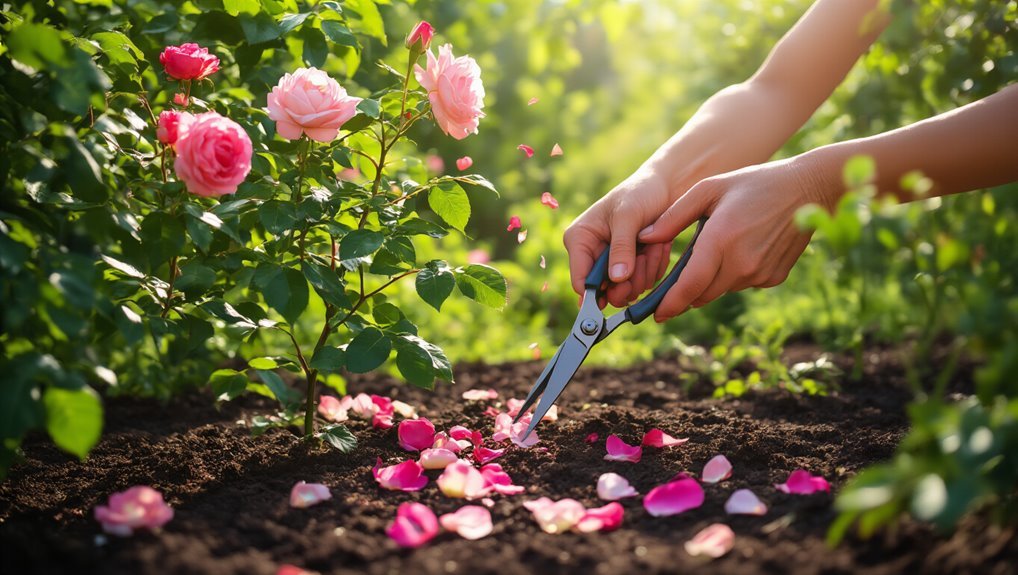
To keep your flowers vibrant and healthy, regular maintenance and trimming are crucial.
Start by checking for wilted or dead blooms; removing these allows your plants to focus energy on healthy growth. Don’t forget to trim the leaves too, especially if they’re yellowing or browning. One way to prevent infestations is to use garden pest traps, which can help keep common pests away from your flowers.
Always use sharp, clean scissors to make clean cuts, preventing damage to the stems. You should also trim stems at an angle to enhance water absorption.
Consider changing the water every few days, refreshing it with nutrients if necessary. Additionally, dusting off leaves can improve photosynthesis.
If you want to protect your flowers from pests and environmental damage, you might consider using garden netting, which can be an effective barrier while still allowing sunlight and water to reach your plants.
Regularly maintaining your flowers not only enhances their appearance but also extends their lifespan, ensuring you enjoy their beauty for as long as possible.
Troubleshooting Common Issues
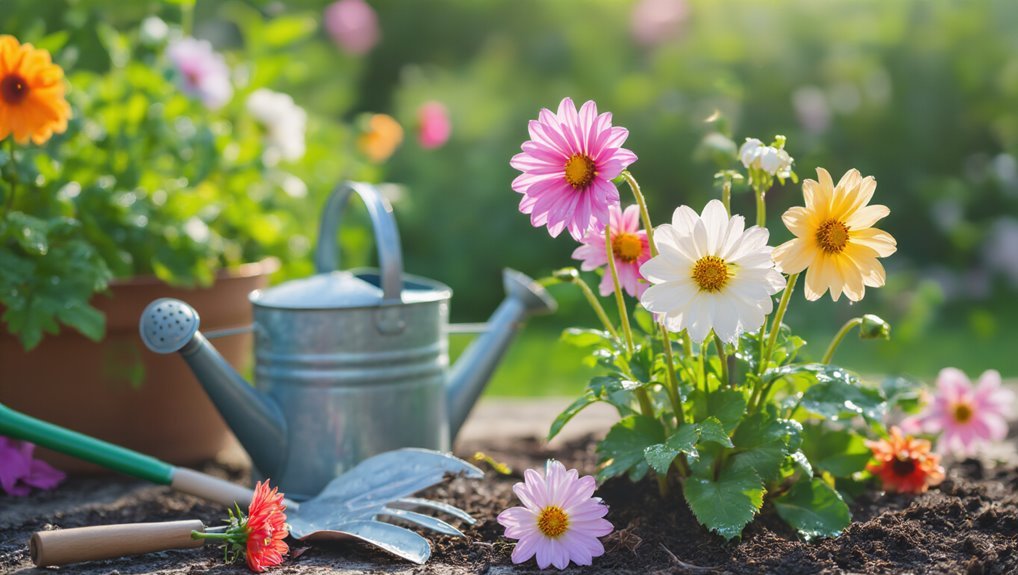
Even the most diligent flower care can lead to unexpected challenges, so knowing how to troubleshoot common issues is essential.
Here are some typical problems and quick fixes you can try:
- Wilting Leaves: Ensure your flowers are getting enough water but not sitting in soggy soil. Adjust your watering schedule accordingly.
- Yellowing Leaves: This could indicate overwatering or nutrient deficiencies. Check your soil moisture and consider fertilizing. You might also want to explore organic pest control solutions if you suspect pests are contributing to the problem.
- Pest Infestations: Inspect your flowers for pests like aphids or spider mites. Use insecticidal soap or neem oil for treatment.
- Fading Blooms: If blooms are fading prematurely, they may need more sunlight. Relocate them to a brighter spot if necessary.
For stubborn pest problems, you may want to consider using effective pest control products specifically designed to target common flower pests and keep your plants healthy.
Frequently Asked Questions
How Often Should I Replace the Water in the Vase?
You should replace the water in your vase every two to three days. This keeps the flowers fresh, prevents bacteria growth, and ensures they stay vibrant longer. Don’t forget to trim the stems while you’re at it!
Can I Mix Different Flower Types in One Arrangement?
When it comes to mixing different flower types in one arrangement, you can absolutely do it! Just remember, variety is the spice of life. Choose complementary colors and shapes for a stunning display that wows everyone.
What Are the Benefits of Using Flower Food?
Using flower food boosts your arrangements’ longevity, providing essential nutrients and hydration. It helps prevent bacteria growth, ensuring your blooms stay vibrant and fresh longer. You’ll appreciate the difference in beauty and lifespan with proper care.
How Can I Revive Wilted Flowers Quickly?
When it comes to reviving wilted flowers, you’ve got to strike while the iron’s hot! Trim the stems, place them in warm water, and add a bit of sugar or flower food for a quick refresh.
Are There Specific Flowers That Are Toxic to Pets?
Yes, some flowers are toxic to pets. For instance, lilies, azaleas, and daffodils can cause severe reactions. It’s crucial you research any plants you bring home to ensure your furry friends stay safe and healthy.
Conclusion
By following this flower care guide, you’re sure to keep your blooms vibrant and fresh. Remember, “a rose by any other name would smell as sweet,” but without proper care, even the most beautiful flowers can wilt. Keep your flowers well-watered, placed in the right spot, and regularly trimmed. With a little effort, you’ll enjoy their beauty longer and brighten your space. So, get to it and let your flowers thrive!
